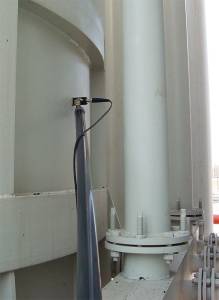Vesta – System for Fast Estimation of the Transformer Winding and Coil Clamping Force

The force of the winding clamping of high voltage transformers specifies their resistance to against short circuit currents which could pass through the transformer under failure conditions.
The clamping force usually weakens with time that is why the clamping force monitoring is an important diagnostic task.
Most of the systems for clamping force diagnostics require, at least, the monitored transformer deenergizing and bus disconnection. "Vesta" system allows assessing the winding and core clamping condition on-line, using the surface transformer tank vibration as the diagnostic parameter.
The "Vesta" system operation is based on the mathematic model of the transformer, where only the active elements (core and windings) are considered to be the source of vibration. According to the mathematic model, only the core vibrates at transformer running with no load, and the winding vibrations add when running on load. If the winding is well-pressed then it vibrates with the frequency of 100 Hz. If the winding clamping force is less than normal, then high harmonics multiple by 100 Hz (200, 300, ... 1000 Hz) appear in the vibration spectrum.
For the expert system operation the vibration should be measured in the spectrum of up to 1000 Hz at 12 typical points on the transformer tank. The points are situated on the level of the top and bottom edges of the transformer phase windings of the HV and LV side of the transformer. The vibration should be measured in two operation modes: with no load and on load – the load should be maximally close to the nominal load.
Transformer Tank Vibration Measurements

The vibration measurements are carried out with the portable vibrometer (Diana-2M, or ViAna-1, or Vibro Vision-2) included into the delivery set of "Vesta" system. The vibration sensor is fixed on the transformer tank surface with a magnet. For the sensor installation the insulating rod is usually used.
While the transformer tank vibration is being measured, the information is being stored in the device memory. The memory volume is enough for storing the data of 40 transformers' inspections. Later the data is uploaded to PC and is stored in «Vesta» expert software database.
The estimation of the transformer winding and core clamping quality is done automatically by "Vesta" expert system. The user should only select the two measurements done at the two different operation modes from the database.
For quantitative evaluation of the winding clamping quality the "condition coefficients" are calculated. This allows getting the unified diagnostic conclusions for almost all the transformer types used nowadays.
Condition Assessment Methods

The condition thresholds of the monitored parameters are specified as follows:
- If the calculated condition coefficient (for the transformer condition, or winding condition, or core condition) is more than 0.9, then the condition is normal.
- If the calculated condition coefficient is less than 0.9 but more than 0.8, then the condition is warning.
- If the calculated condition coefficient is less than 0.8 then the transformer condition is alarm, so the improvement measures should be taken or at least planned.
«Vesta» software automatically makes the report on the clamping quality of the transformer active elements. The report includes the complete information and pictures, and can be printed.




